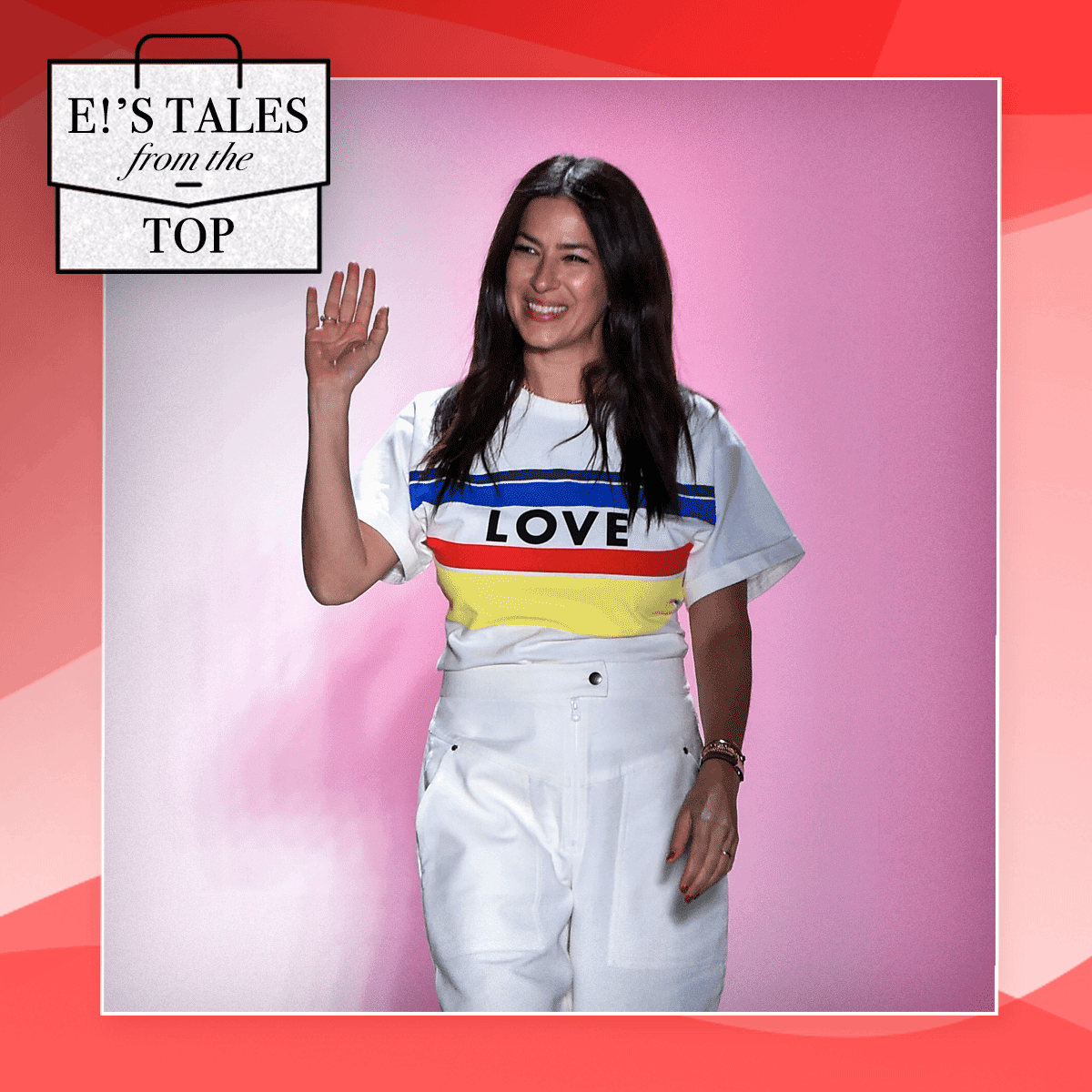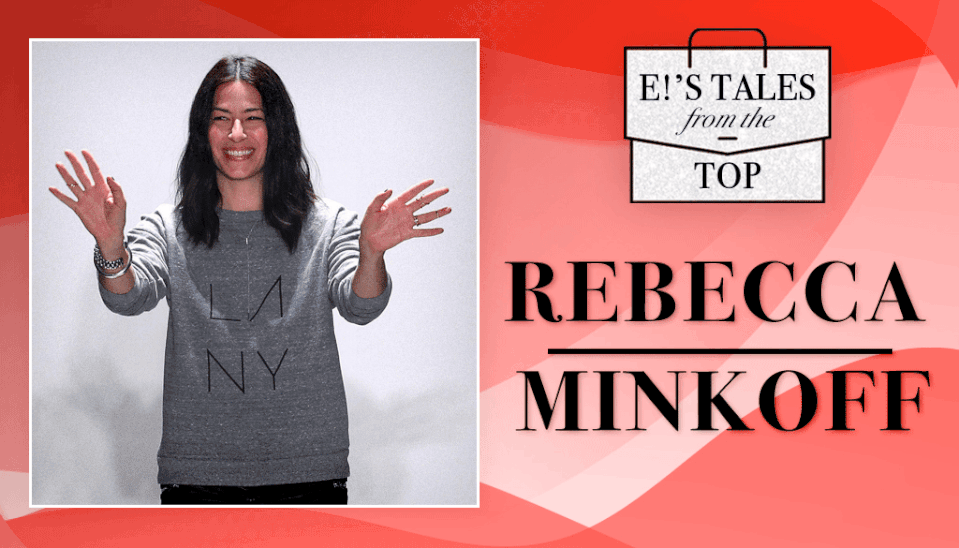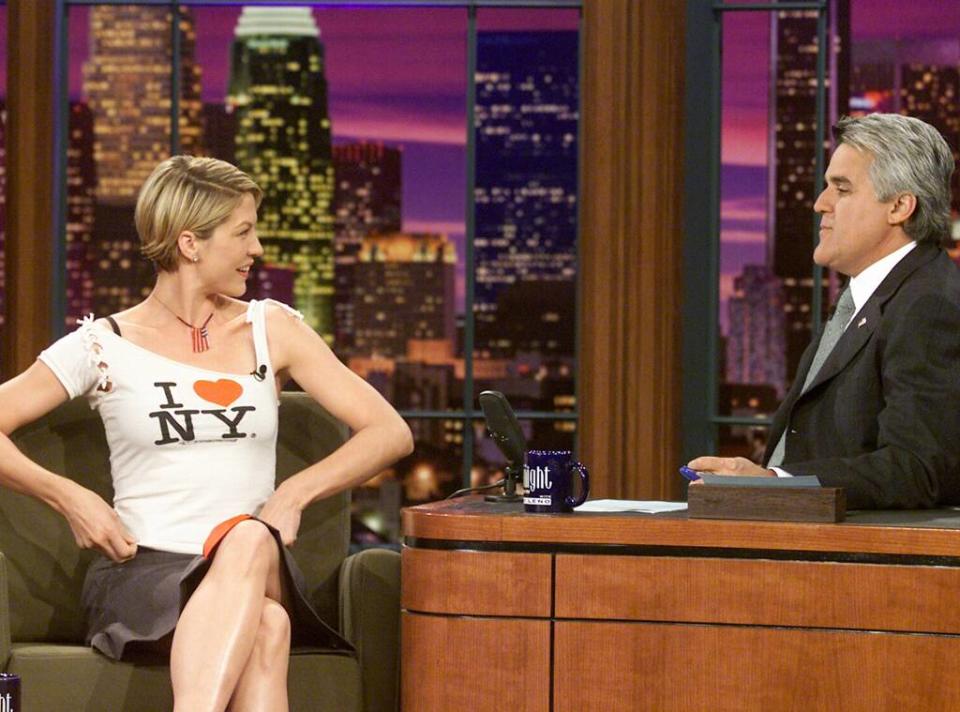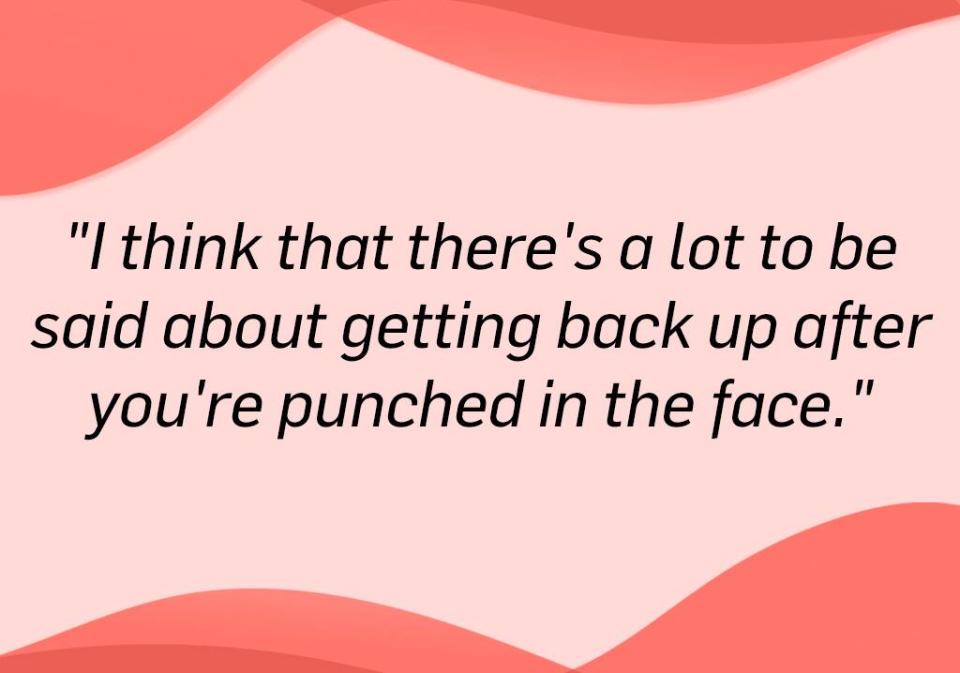Inside Designer Rebecca Minkoff's Jam-Packed Bag of Career Lessons

Welcome to E!'s Tales From the Top, our series on women who are leaders in their fields and masters of their craft. Spanning industries and experiences, these powerhouse women answer all the questions you've ever had about how they got to where they are today—and what they overcame to get there. Read along as they bring their resumés to life.
Almost 20 years ago, Jenna Elfman made an appearance on The Tonight Show with Jay Leno, sporting an I Love NY shirt that had been cut up and tied. The woman behind the redesign? Rebecca Minkoff.
Fresh off a trip to the Bahamas, Minkoff was inspired by the T-shirts travelers would return home. "I was like, 'I really like how the shirts are all cut up and they have those plastic beads with the knots," she recalled in an exclusive interview with E! News, "but I don't want something that says Aruba. I want something that says New York.' And so I just made one for myself and then put it in the line."
It was far from the first time she made something for herself—the famed designer learned sewing as a kid and even created her own bat mitzvah dress. Then, while in her performing arts high school, Minkoff ended up spending a lot of time in the costume department. "Growing up, I thought I wanted to be a dancer, but there were just enough odds against that happening with my height, the size of my chest, the fact that I started dancing a little bit late," she explained, "that it just didn't seem like it was going to be in the cards for me."
Fashion, however, was. After graduating, Minkoff moved to New York City with a paid internship at Craig Taylor, the since-shuttered shirt brand, where she worked her way up to senior designer. On the side, she had designed her own small collection when, by a chain of chance events, Elfman suddenly became her walking billboard.
Rebecca Minkoff Talks Spring Styles & Jessica Alba
"My sister-in-law saw [the shirt] and she wanted one, so I made her one and then she was at dinner with Jenna because my brother and her husband are very close," Minkoff recalled. "Jenna was like, 'Who made that? I want one'...I got so excited when I got that phone call and made her one and sent it to her on Sept. 9, 2001."
Mere days later, the nation faced the tragedy of the Sept. 11 terrorist attacks and Elfman, in solidarity with the city forever changed, decided to wear the shirt on The Tonight Show less than a month later. While the internet was hardly the e-commerce macrocosm it is today, the origins of online retail were taking shape. "There was one little e-commerce site that had the shirt and she was just suddenly flooded with orders and it just kept going," she said. "It was like nine months of people wanting that shirt."

As the garment took off, the CEO at work bid Minkoff farewell. "She was like, 'I love you. You know what you're doing. Go do it. You're fired,'" Minkoff recalled. "And I was like, 'I don't know that I know what I'm doing'...We're still close and I was like, 'What was going through your head back then?' And she just was like, 'I needed you to choose between going all in with me or going all in with you and I knew you wouldn't choose me.'"
However, she's careful to note the shirt's fandom offered more of a foot in the door than an overnight success story. "It really was just that I could call a store, they would not hang up on me," Minkoff said of her newfound, albeit vague name recognition. After four more years of keeping her small apparel company afloat, supplemented by styling gigs, the first Rebecca Minkoff bag was born—with some more help from Elfman.
"Jenna and I were having lunch and she said, 'Do you make bags? Because my character has a bag that she carries throughout the film and it would probably be good exposure for you.' So I just lied to her and I said, 'Yes, I make bags.'" While Minkoff had not actually been making bags back in 2005, she was designing leather jackets. Armed with a two-week deadline and addresses of factories that her leather vendor worked with, she sought out one that had a reputable brand on its roster. Eventually, she landed on what she was looking for, but the finished product ended up getting to the actress too late.
"It didn't make it into the film on time. It was gut-wrenching and devastating," she recalled. "That was my last 1,600 bucks that I had and I was like, 'I guess I just bought my first designer bag.'"

But, it was far from money wasted. "I'd made two, one for her, one for me, so I could get press with it," she said, "and I just started carrying it around New York City." As more random women stopped her on the street, Minkoff realized there was something great about the bag and considered putting it in her line. Adding to the momentum, a buyer friend ordered some for a celebrity go-to store in Los Angeles and helped get the purse—called the Morning After Bag, a signature of the brand today—featured on the popular, now-defunct style site DailyCandy.
"When DailyCandy hit, it was like...I wish you could create those spikes again with one email going to a database," Minkoff reminisced. "But that was the beginning of when you began to see the hockey stick, sort of, sales begin to rise."
From that year on—and with her brother, co-founder and CEO Uri Minkoff, on board—the full-fledged womenswear brand shoppers know today began to take shape with a focus first on bags. As for the many challenges along the way, overcoming them is a crucial part of this success story. "I think that there's a lot to be said about getting back up," the designer said, "after you're punched in the face."
Below, unpack some of the candid career lessons she shared with E! News:
On sustaining a brand:
"I think that people don't realize how hard it is or what is ahead of them and so they get tired and they just get worn down and they're like, 'This is not worth it.' I think that relationships are everything. I think leveraging those, maintaining those."
On asking helpful questions:
"You have five minutes with me. You're going to ask me how I got started—that doesn't help you at all. You could ask for a leather resource or a factory or an introduction to somebody, something that's going to propel you next versus hearing my history."
On the punch-you-in-the-face moments she experienced:
"Not that anyone would ever complain about growth, but in the beginning, the growth was so swift and things like private equity and venture capital weren't even things that were happening in this space, and so, when you couldn't get a loan from a bank and you also couldn't raise money or people weren't raising money, how do you keep up with the growth? You pay less staff, you pay yourself nothing and everything goes into the company. You're on such thin ice that everything has to go perfect. The bags have to arrive on time. You have to get paid on time. You're definitely living in a tense environment and that can get stressful. When you have a wrong zip code in your new shipping platform and it holds up and messes up 8,000 orders, that's definitely a throw-in-the-towel moment."

On how to nail a pitch:
"Practice. Practice with your friends, practice with your family, practice in front of a mirror, videotape yourself and practice. I also think it's a really good idea if you are pitching...At the end of the day, you're going to get money from one person or one group. Make 50 other appointments with people whose money you never want and make those appointments first, just so you can fail in front of all of them and figure it out and sort of test what you do and what works."
On a sales moment she unforgettably bombed:
"I went to Saks Beverly Hills and had a trunk show and I was so excited and nervous and, literally, I stood in front of my bags and pointed people to the bathroom. That was a a fun moment. No one cared. They were like, 'Oh, someone's standing here who looks like she works here. Where's the bathroom, ma'am?'"
On what she would have told herself in that situation:
"I probably would have said, 'You know what? I need to get more aggressive with talking to the people that are talking to me about my bag.' And not be shy about saying, 'I'm actually a designer and I'm here doing a trunk show. This is the bathroom, but please come back. I'd like to show you my stuff.'"
On the advice she'd go back and give herself:
"We did a lot of things that were innovative and first movers in so many arenas and we were always met with skepticism and 'Don't do that' and we did it anyways, but it would have been nice to not have the fear. It would have been nice to not worry about what anyone thought and just proceeded, because I think we could have even done more innovative things and been further along technology-wise as a company had we just said, 'Screw it. They don't want us to work with influencers, they don't want us to talk to our customer—let's talk to them even more.' Even though I dove in, there was a slight hesitancy of sort of pulling back."
Fearless: The New Rules for Unlocking Creativity, Courage, and Success is available now.
